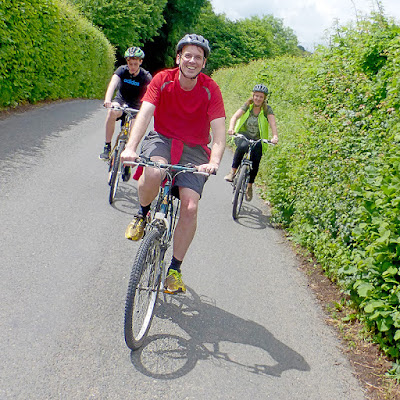 |
| Examples of the various draft circular route sheets in the Teme Valley. |
The informal user-test method has proven really useful for the 6x walks we've created as part of the Teme Valley Trail (see previous post on this blog) and we're keen to continue the testing regime with the new cycle trails too. As with the 6x walking route maps, there are also 6x cycle trail maps - they vary from 'easy' (mainly flat on minor roads/lanes) to 'challenging' (including occasional steep up or downhill sections and occasional small sections of green lane).
Each cycle route will have sites to look at en route that may be of interest - including rural churches (both ruined and intact), family farms and ancient downland racecourses to name but some.
Weather-allowing, we'll try to pre-plan in cycle test groups on occasional sundays throughout May, June and (if needs) early July. I'll post updates in advance to those interested via e-mail along with meet locations/timings, clothing & kit suggests and a .pdf copy of the A4 route map to be tested on the day.
Additionally (you'll be pleased to hear), each route has been designed so it incorporates either a cafe en route or a pub in case cyclists wish to quench their thirst (and ruin all that good done with crisps and cake)..
Provisional dates and rides: (Weather permitting, all distances & times approximate)
Ride 1: Completed
• Sunday 8th May - Stanford on Teme, Riding: easy
' Some of the best cycling lanes in Worcestershire' - Lyndon, Bracewell, CTC Worcester
Pictures from the test ride:
 |
| Our draft route sheet for the day.. |
 |
| Some of our test group for the day on the quiet lanes around Shelsley Walsh. |
 |
| Intricate woodwork and carvings inside Shelsley Walsh's little church. |
 |
| More like a cycle ride in deepest France, some of the lovely scenery en route. |
Ride 2: Completed
• Sunday 29th May - Martley, Riding: easy
 |
| Our draft route sheet for the day. |
 |
| Our test team enjoying a reviving cold drink post ride. |
 |
| Wichenford Dovecote (Free Entry, National Trust) |
 |
| The amazing half-timbered barn next to Wichenford Dovecote |
 |
| One of the incredibly well-preserved ancient wall paintings in Martley Church. |
Ride 3: Completed
• Sunday 12th Jun - Bransford, Riding: easy
 |
| Our draft route sheet for the day. |
 |
| A cathedral of wood - the amazing Leigh Court Barn (en route). |
 |
| We passed fields full of poppies. |
 |
| Post ride discussion and feedback on the route. |
 |
| Some of our test cyclists out on the route. |
Ride 4: Completed
• Sunday 19th Jun - Tenbury Wells, Riding: easy-medium
 |
| Our draft route sheet for the day. |
 |
| Outside Tenbury's 'Pump Rooms'. |
 |
| Slowly riding up one of the two hills encountered. |
 |
| The front and rear of our group as they cross Oldwood Common. |
Ride 5: Completed
• Sunday 26th Jun - Pencombe/Bromyard, Riding: medium-tough
 |
| The draft route map for the day.. With added Daleks! |
 |
| Our excellent cycling test team for the day.. |
 |
| Coming down the fantastic downhill section from the hill at Shortwood family farm. |
 |
| Stopping for a quick breather.. |
Ride 6: Completed
• Sunday 10th July - Cleobury Mortimer, Riding: medium-tough
 |
| Our draft route sheet for the day.. |
 |
| Our excellent test team for the day.. |
 |
| The lovely little church at Neen Savage. |
 |
| Our test folks taking refuge in the New Inn.. |
 |
| Daughter Libby and yours truly on a break at the New Inn. |
 |
| To heck with the rain! :) |
Yes, count me in?
If interested in joining us for some informal testing, then please e-mail me initially on: bumblebee.email@gmail.com
Many thanks, Andy :)
















